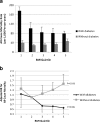Body-Mass Index and All-Cause Mortality in US Adults With and Without Diabetes
- PMID: 23929218
- PMCID: PMC3889975
- DOI: 10.1007/s11606-013-2553-7
Body-Mass Index and All-Cause Mortality in US Adults With and Without Diabetes
Abstract
Background: Previous studies found normal weight compared to overweight/obese adults with type 2 diabetes had a higher mortality risk, and body-mass index (BMI)-mortality studies do not typically account for baseline diabetes status.
Objective: To determine if diabetes influences the BMI-mortality relationship.
Design: Using a prospective study design, we analyzed data from a nationally representative sample of US adults participating in the National Health Interview Survey from 1997 to 2002, and followed for mortality through 2006.
Participants: Excluding those with heart disease or cancer, our final analytic sample included 74,710 (34,805 never smoker) adults.
Main measures: BMI was calculated from self-reported height and weight. Diabetes status was based on self-reported diagnosis from a health professional. We used direct age standardization to calculate all-cause mortality rates and adjusted Cox models for all-cause mortality hazard ratios by BMI quintile; this was done separately for adults with diabetes and without diabetes.
Key results: Among never smokers, mean age was 50.1 years and 43 % were men. Mean BMI was 27.4 kg/m(2), 26 % were obese, and 2,035 (5 %) reported diagnosed diabetes. After 9 years, there were 4,355 deaths (754 of 4,740 with diabetes; 3,601 of 69,970 without) among 74,710 participants, and 1,238 (247 of 2,035 with diabetes; 991 of 32,770 without) among 34,805 never smokers. We observed a qualitative interaction with diabetes on the BMI-mortality relationship (p = 0.002). Death rates were substantially higher among participants with diabetes compared to those without diabetes across all BMI quintiles. However, death rates in participants with diabetes fell with increasing BMI quintile, while rates followed a J-shaped curve among those without diabetes. In adjusted Cox models, BMI was positively associated with mortality in adults without diabetes, but inversely associated with mortality among participants with diabetes.
Conclusions: Mortality increased with increasing BMI in adults without diabetes, but decreased with increasing BMI among their counterparts with diabetes. Future studies need to be better designed to answer the question of whether normal weight adults with diabetes have a higher risk of mortality, by minimizing the possibility of reverse causation. Future studies should also account for prevalent diabetes in all investigations of the BMI-mortality relationship.
Figures

Comment in
-
Is mortality risk reduced in overweight or obese diabetics?J Gen Intern Med. 2014 Jan;29(1):3-4. doi: 10.1007/s11606-013-2608-9. J Gen Intern Med. 2014. PMID: 24002636 Free PMC article. No abstract available.
References
-
- Ogden CL, Lamb MM, Carroll MD, Flegal KM. Obesity and socioeconomic status in adults: United States, 2005–2008. NCHS Data Brief 2010:1–8. - PubMed
-
- Overweight, obesity, and health risk. National Task Force on the Prevention and Treatment of Obesity. Archives of internal medicine. 2000;160:898–904. - PubMed
Publication types
MeSH terms
Grants and funding
LinkOut - more resources
Full Text Sources
Other Literature Sources
Medical

